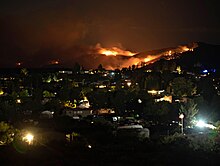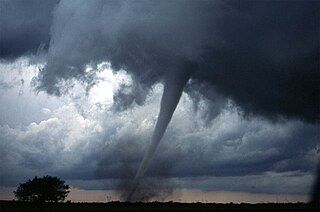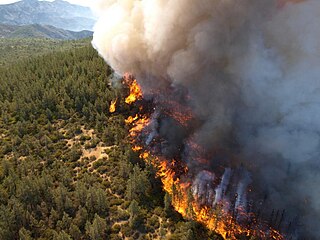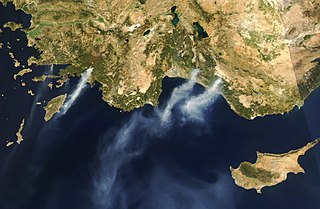Africa

- 2021 Algeria wildfires
- 2021 Table Mountain fire, South Africa
| 2021 wildfire season | |
|---|---|
| Statistics | |
| Date(s) | January–December 2021 |
| Season | |
← 2020 2022 → | |
The 2021 wildfire season involves wildfires on multiple continents. Even at halfway through the calendar year, wildfire seasons were larger than in previous history, with increased extreme weather caused by climate change (such as droughts and heat waves) strengthening the intensity and scale of fires. [1]
Below is a partial list of articles on wildfires from around the world in the year 2021.





Extreme weather includes unexpected, unusual, severe, or unseasonal weather; weather at the extremes of the historical distribution—the range that has been seen in the past. Extreme events are based on a location's recorded weather history. They are defined as lying in the most unusual ten percent. The main types of extreme weather include heat waves, cold waves and heavy precipitation or storm events, such as tropical cyclones. The effects of extreme weather events are economic costs, loss of human lives, droughts, floods, landslides. Severe weather is a particular type of extreme weather which poses risks to life and property.

Climate change in California has resulted in higher than average temperatures, leading to increased occurrences of drought and wildfires. During the next few decades in California, climate change is likely to further reduce water availability, increase wildfire risk, decrease agricultural productivity, and threaten coastal ecosystems. The state will also be impacted economically due to the rising cost of providing water to its residents along with revenue and job loss in the agricultural sector. California has taken a number of steps to mitigate impacts of climate change in the state.

Climate change in Colorado encompasses the effects of climate change, attributed to man-made increases in atmospheric carbon dioxide, in the U.S. state of Colorado.

The 2017 wildfire season involved wildfires on multiple continents. On Greenland, which is mostly covered by ice and permafrost, multiple fires occurred in melted peat bogs, described as "unusual, and possibly unprecedented". Popular media asked whether the wildfires were related to global warming. Research published by NASA states "climate change has increased fire risk in many regions", but caused "greater severity in the colder latitudes" where boreal and temperate forests exist, and scholars have described "a warm weather fluctuation that has become more frequent in recent decades" related to wildfires, without naming any particular event as being directly caused by global warming.

Wildfires can happen in many places in the United States, especially during droughts, but are most common in the Western United States and Florida. They may be triggered naturally, most commonly by lightning, or by human activity like unextinguished smoking materials, faulty electrical equipment, overheating automobiles, or arson.

The 2020 California wildfire season, part of the 2020 Western United States wildfire season, was a record-setting year of wildfires in California. By the end of the year, 9,917 fires had burned 4,397,809 acres (1,779,730 ha), more than 4% of the state's roughly 100 million acres of land, making 2020 the largest wildfire season recorded in California's modern history, though roughly equivalent to the pre-1800 levels which averaged around 4.4 million acres yearly and up to 12 million in peak years. California's August Complex fire has been described as the first "gigafire", burning over 1 million acres across seven counties, an area larger than the state of Rhode Island. The fires destroyed over 10,000 structures and cost over $12.079 billion in damages, including over $10 billion in property damage and $2.079 billion in fire suppression costs. The intensity of the fire season has been attributed to a combination of more than a century of poor forest management and higher temperatures resulting from climate change.

A megafire is an exceptional fire that devastates a large area. They are characterised by their intensity, size, duration and uncontrollable scale. There is no precise scientific definition.
The 2020 Uttarakhand forest fires started in late May, after several forest fires broke out in Srinagar of Pauri Garhwal district in Uttarakhand, India. As of 24 May 2020, 46 fires were reported covering around 71 hectares and 2 people have died.

The Western United States experienced a series of major wildfires in 2020. Severe August thunderstorms ignited numerous wildfires across California, Oregon, and Washington, followed in early September by additional ignitions across the West Coast. Fanned by strong, gusty winds and fueled by hot, dry terrains, many of the fires exploded and coalesced into record-breaking megafires, burning more than 10.2 million acres of land, mobilizing tens of thousands of firefighters, razing over ten thousand buildings, and killing at least 37 people. The fires caused over $19.884 billion in damages, including $16.5 billion in property damage and $3.384 billion in fire suppression costs. Climate change and poor forest management practices contributed to the severity of the wildfires.
This is an environmental history of the 2020s. Environmental history refers to events and trends related to the natural environment and human interactions with it. Examples of human-induced events include biodiversity loss, climate change and holocene extinction.

The following is a list of weather events that occurred in 2021. The year began with La Niña conditions. There were several natural disasters around the world from various types of weather, including blizzards, cold waves, droughts, heat waves, tornadoes, and tropical cyclones. In December, powerful Typhoon Rai moved through the southern Philippines, killing 410 people and becoming the deadliest single weather event of the year. The costliest event of the year, and the costliest natural disaster on record in the United States, was from a North American cold wave in February 2021, which caused $196.4 billion (USD) in damage; the freezing temperatures and widespread power outages in Texas killed hundreds of people. Another significant natural disaster was Hurricane Ida, which struck southeastern Louisiana and later flooded the Northeastern United States, resulting in $70 billion (USD) in damage. December saw two record-breaking tornado outbreaks, only four days apart from each other. In Europe, the European Severe Storms Laboratory documented 1,482 weather-related injuries and 568 weather-related fatalities. The National Oceanic and Atmospheric Administration documented 796 weather-related fatalities and at least 1,327 weather-related injuries in the United States and the territories of the United States.

A drought developed in the Western, Midwestern, and Northeastern United States in the summer of 2020. Similar conditions started in other states in August 2020, including Iowa, Nebraska and certain parts of Wisconsin and Minnesota. At the same time, more than 90% of Utah, Colorado, Nevada and New Mexico were in some level of drought. Also in drought conditions were Wyoming, Oregon and Arizona.

From June 2021, the taiga forests in Siberia and the Far East region of Russia were hit by unprecedented wildfires, following record-breaking heat and drought. For the first time in recorded history, wildfire smoke reached the North Pole.

In July and August 2021, a series of more than two hundred wildfires burnt 1,700 square kilometres of forest in Turkey's Mediterranean Region in the worst-ever wildfire season in the country's history. The wildfires started in Manavgat, Antalya Province, on 28 July 2021, with the temperature around 37 °C (99 °F). As of 9 August 2021, two fires were still burning, both in Muğla. The fires are part of a larger series of wildfires, including those in neighbouring Greece, originating from a heatwave made more likely by climate change.

The 2021 Greece wildfires were multiple wildfires in Greece in August 2021, which killed 3 people, injured at least 20 others and burned dozens of homes, after a historic heatwave for the country, with the highest temperatures reaching 47.1 °C (116.8 °F). Authorities evacuated several villages and towns. According to BBC News, Greece experienced the worst heatwave since 1987. These fires were the worst fires in Greece since the 2007 Greek forest fires which burnt more than double the area of the 2021 fires.

The 2022 California wildfire season was a series of wildfires burning throughout the U.S. state of California. By the end of the year, a total of 7,667 fires had been recorded, totaling approximately 363,939 acres across the state. Wildfires killed nine people in California in 2022, destroyed 772 structures, and damaged another 104. The 2022 season followed the 2020 and 2021 California wildfire seasons, which had the highest and second-highest (respectively) numbers of acres burned in the historical record, with a sharp drop in acreage burned.

The 2022 New Mexico wildfire season is an ongoing series of wildfires burning throughout the U.S. state of New Mexico. As of December 13, 2022, 904,422 acres (366,007 ha) had burned across the state. The burned acreage figure for 2022 is well above the 1995-2015 average of approximately 270,000 acres burned annually. with the fire season in the state expected to continue until the advent of the regular North American Monsoon weather pattern throughout the Southwestern United States in the summer.